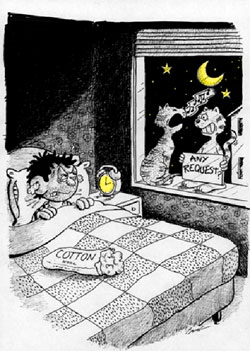
During the cold winter months in much of the country, people often develop the winter blues due to cabin fever. It is also common for pets to get cabin fever, and they may develop behavior problems as a result of boredom or frustration. These undesired behaviors can become permanent habits if they are not interrupted quickly. If your pet suddenly develops an undesirable behavior such as housesoiling, destructive chewing, or restlessness, it is important to visit your veterinarian to rule out any medical issues.
Once any potential health issues are ruled out or treated, there are some simple things you can do to provide mental stimulation and indoor activities as a substitute for outdoor exercise. Follow the 5 W’s of Why, Who, What, When and Where to develop your pet’s personalized cabin fever relief program.
Why? It’s important to provide mental stimulation as an alternative to physical exercise on lazy or cold days so that your pet does not become anxious, frustrated, or bored. Short indoor training sessions or play breaks will work to break the boredom and help form good bonds between family members and the pet.
Who? If the intention is to stimulate your pet’s interest and focus, it is good to vary the people who are playing with or training the pet. Everyone in the family should participate. Toddlers can toss toys for your dog or cat to chase or retrieve, while older children can teach new tricks to the pet. Anyone, including visitors, can participate in a game of catch or hide-and-seek around the house, which can encourage the pet’s natural inquisitive nature and be much more stimulating than you might expect. Another stimulating activity that you can share with friends is a “towel trade” – rub your pet with a fresh towel, then trade this ‘scented towel’ with a friend who has done the same with their pet. Allow your pet to investigate the new smells that are on the towel.
What? Alternate play toys and differ the activity in each session or each week. Polish up old tricks or teach new tricks, such as teaching your pet to differentiate between left and right paw shakes, ‘high fives’ versus shakes, etc. You are only limited by your imagination and your pet’s cooperation. Having fun is the key. Contrary to popular belief, most cats can also be trained to do simple tricks such as sit, roll over, give a paw, etc. An extremely useful trick to teach any pet is that whenever a doorknob is touched, the pet must sit still before the door is opened – this will prevent dangerous bolting through doorways. For best results, include indoor professional training courses to provide additional stimulation and allow your pet to socialize with other pets.
When? It can be hard to find time for a long training session, particularly if you are also faced with the winter blues. However, it can be easy to break playtimes up into very short intervals – such as during commercial breaks, while waiting for the kettle to boil or the toaster to pop, or before feeding your pet. Multiple short games are usually more stimulating than one long one.
Where? Although this can seem challenging at first, you should realize that there is no need for a large space for effective training. With your dog, you can snap on the leash and work with controlled walking from room to room, or up and down stairs. With your cat, you can encourage exercise by tossing her favorite toy up and down the stairs to provide aerobic exercise.
For pet families that have indoor cats, you can incorporate these suggestions year-round to enrich your cat’s life and avoid undesirable behavior problems. Check our website for more detailed handouts, or call the clinic for specific advice that is tailored to your situation.
————————————
Caution: These news items, written by Lifelearn Inc., are licensed to this practice for the personal use of our clients. Any copying, printing or further distribution is prohibited without the express written permission of Lifelearn Inc. Please note that the news information presented here is NOT a substitute for a proper consultation and/or clinical examination of your pet by our clinic veterinarian.


